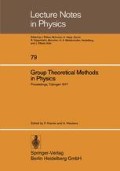Abstract
We treat here the case of all irreps (irreducible representations) on the reals of the 32 point groups. For each point group these irreps are irreps with wave vecor k = 0 of the corresponding space groups. Landau model of second order phase transition can be applied to those irreps with no third degree invariants : one has to look for minima of a bounded below fourth degree polynomial which is not minimum at the origin, and determine the little groups (= isotropy groups) of these minima ; they are the subgroups into which the symmetry can be broken in the transition. By an efficient strategy we reduce the study of the 153 equivalence classes of irreps to few cases (6). Moreover we do not need to study the minima of invariant polynomials, we simply apply Morse theory to find the possible little groups of minima.
Preview
Unable to display preview. Download preview PDF.
References
L.D. LANDAU, Phys. Z. Soviet. 11 (1937) 26, 545 (transi. in L.D. LANDAU “Collected Papers”, ed. D. ter Haar, Pergamon (1965)).
L.D. LANDAU, E.M. LIFSCHITZ, Statistical Physics, English transl. Pergamon, London (1958).
E.M. LIFSCHITZ, Soviet Journal of Physics 6, 61, 251 (1942).
J. MOZRZYMAS, Bull. Acad. Polon. Sci., Ser. math., astr. et phys., 23 (1975) 485,493, 499.
G.L. BIR, G.E. PIKUS, Symmetry and Strain-induced Effects in Semiconductors, John Wiley & Sons, N.Y. 1974.
L. MICHEL “Invariant polynomiaux des groupes de symétrie moléculaire et cristallographique”, Proc. Vth International Colloquium on Group Theoretical Methods in Physics, Montreal (1976) (Academic Press, New York 1977–8).
J.L. BIRMAN, Phys. Rev. Lett., 17 (1966) 1216, 167 (1968) 528.
J.L. BIRMAN, Group Theory of the Landau-Thermodynamic Theory of Continuous Phase Transitions in Crystals, (Proceedings this Colloquium).
C. CHEVALLEY, Amer. Jour. Math. 77 (1955) 778.
M.S. SHUR, Zhetf, 51 (1966), 1260.
L. MICHEL, L. O'RAIFEARTAIGH, K.C. WALI, Phys. Rev., 15D (1977), 3641.
Author information
Authors and Affiliations
Editor information
Rights and permissions
Copyright information
© 1978 Springer-Velag
About this paper
Cite this paper
Michel, L., Mozrzymas, J. (1978). Application of Morse theory to the symmetry breaking in the Landau theory of second order phase transition. In: Kramer, P., Rieckers, A. (eds) Group Theoretical Methods in Physics. Lecture Notes in Physics, vol 79. Springer, Berlin, Heidelberg. https://doi.org/10.1007/3-540-08848-2_46
Download citation
DOI: https://doi.org/10.1007/3-540-08848-2_46
Published:
Publisher Name: Springer, Berlin, Heidelberg
Print ISBN: 978-3-540-08848-6
Online ISBN: 978-3-540-35813-8
eBook Packages: Springer Book Archive

